Cat Rambo's Blog, page 24
April 23, 2019
Norwescon Editing Panel(s) Notes
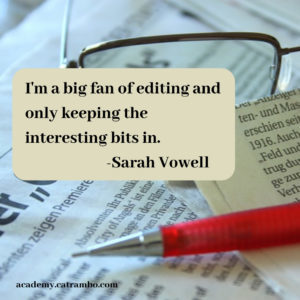 I was on two different editing panels at Norwescon this weekend.
I was on two different editing panels at Norwescon this weekend.
I’ve taken the liberty of combining my notes from both panels, but my notes from the first panel are much better and actually contain a page of quotes from participants, while on the second panel, which was my 4th of the day, I was much less energetic and just wrote down the questions and two notes, and am reconstructing some things from my memory, so I cannot vouch for total accuracy. In each panel, we did something that I picked up from Mary Robinette Kowal, taking questions from the audience before starting the panel, and using those to drive the conversation. It’s a great technique for wide-ranging, discussion-driven panels.
Want to Be An Editor?
Where can or do you begin? It’s hard to get an editing position when you don’t have work under your belt. Listen to editors share the details of how they got started and learn some of the pitfalls to avoid.
Chimedum Ohaegbu, Gordon Van Gelder, Cat Rambo, Jasmine Silvera
Need An Editor?
Need an editor? What can you expect? How do you find one that fits within your budget, has a good reputation, and is knowlegeable of your genre?
Cat Rambo, Cory Skerry, Rhiannon Held, Jasmine Silvera
How do you deal with the challenge of editing large numbers of submissions?
GVG: You have to start by determining what the final project will be like – then you use the question of what’s best for it to winnow down submissions. Knowing the size and scope of the project helps enormously.
CO: A cohesive vision is important. In working with an undergrad lit magazine, she sometimes redirects manuscripts, “This isn’t right for us, but you might try Place X.”
RS: Works with very long pieces, so she finds that “It’s easy to tell if a story is worth the word count.”
GVG: One consideration is that you need big name authors to sell an anthology, but it’s a balancing act. He told a story of turning down a story from Ray Bradbury and getting a much better one a week later.
CR: The dirty secret of editing is that most editors read the first page or so and use that to determine whether or not they want to keep reading.
What are the different forms of editing?
An acquisitions editor for a publishing house reads and selects manuscripts that they want to work with.
A development edit applies to an early draft, covers big picture stuff. For example, Cat’s usual developmental edits are the manuscript with comments and changes track on, a 3-5k document that is an overview plus chapter by chapter notes, and a follow up in a video call to talk about the notes.
Copy or line edit looks at line by line stuff, like typos, grammatical errors. It may include fact-checking, or that may be a separate pass.
How much does a day job in something like editing technical documentation translate into fiction editing?
It will help more with copyediting than with developmental editing. To develop your eye for the second, you really need to read in the field, which will help you develop an eye for tropes and story structure.
How does being an editor affect your writing?
A small groan escaped most of the panelists at this particular question, and the writers felt that editing can have both good and bad effects on your writing. It can sharpen your skills and make you articulate what you find wrong about a story or sentence — but it also takes energy and creativity from the same wellsprings that produce writerly words.
How does one move from being a hobbyist editor to a professional one?
Make it known that you’re accepting clients: mail friends & family as well as people you’ve edited for, promote on your website and in social media. Let friends who are editors know that you’re doing it; sometimes they may pass off clients they don’t have the schedule for.
Are there standardized editing formats and marks that an editor should know?
Most editors give the writer a Word document with track changes showing what they changed as well as comments and suggestions. The writer then goes through the manuscript accepting (or rejecting) the changes that have been made. There are industry proofreading marks, but they are applicable to hard-copy documents rather than electronic ones.
How do you get started editing?
RS: Fell into it because Ann Leckie asked her to edit Giganotasaurus and said, “Just read some stories and pick some things.”
GVG: Came up through the traditional publishing process, starting as an intern, and working in publishing. Important to emphasize that everybody’s journey is different.
CR: Was asked because of a combo of having submitted to the magazine multiple times plus the recommendation of someone she’d collaborated with.
Most magazines need slush readers and try to recruit them periodically. Follow them on social media to find out when they’re looking for them.
How is critiquing a manuscript for a critique group different than editing?
Usually stories being critiqued in a critique group are not as far along as a finished story that’s been submitted. A critique group usually provides developmental feedback rather than line edits or proofreading.
How far along in the writing process should you hire an editor?
Early on, as in first or second draft, is when you would want developmental editing. Later on, when you think the draft is as perfect as you can make it, is the time for copyediting.
How do you evaluate an editor?
CS: Most editors will do a sample edit of a few pages for you for free if you request it. Also look on the Absolute Write forums, which are full of discussion.
CR: Talk to a few of their former clients. Check Writer Beware to make sure their name doesn’t pop up and talk to a few of their other clients.
How do you build trust on either side of the editorial process?
GVG: You remember that the editor and author are working together to make the story the best it can be.
Communicate expectations and timeline; avoid surprising each other.
RH: It’s okay to push back on an editorial change, but you have to say why.
How do you listen to editorial feedback without it scarring your soul?
Reading through an edit can be daunting at first, particularly when it’s got a LOT of notes in it. But the editor’s there to be your ally and make the writing better.
You should come away from an edit — if possible — feeling like you learned something from it. A good edit can be both instructional and inspirational.
At what points does an indie writer need an editor?
Mileage varies. Some people may want a developmental edit; others may rely on beta readers or their crit group.
If you’re an indie writer, you really do need to hire a copyeditor for the finished version, because even if you are the best proofreader in the world, you will miss things about your own stuff
What’s a reasonable length of time for an edit to take?
This really depends on the edit as well as your editor’s schedule. CS knows an editor who deducts a percentage if she’s late, but at the same time charges the writer a percentage if they’re late getting it to her.
Communicate expectations and timeline clearly.
What’s a reasonable amount for an editor to charge?
It depends on both the type of edit and the manuscript itself. A light edit is less work and usually an editor will charge less for that than a manuscript where they have to wrestle with every sentence.
Here are the Editorial Freelance Association list of standard fees. If someone’s charging an hourly rate, find out how many pages on average an hour represents.
If you’re on a tight deadline, speeding up the turnaround to meet it will probably cost you more.
How do you go about finding sensitivity readers?
Ask people for recommendations and watch social media. Be aware that a sensitivity reader is not there to provide the official seal of approval from whatever group(s) they represent. They’re there to help you write accurately and avoid hurting people.
April 12, 2019
Crypticon 2019: Where I’ll Be
 Here’s my schedule for Crypticon, here in Seattle at the end of the month. Come say hi if you’re around! I proposed most of these panels, so I’m excited about them.
Here’s my schedule for Crypticon, here in Seattle at the end of the month. Come say hi if you’re around! I proposed most of these panels, so I’m excited about them.
Friday
What Is SFWA and What Does It Offer Me as a Writer?
6 pm, Cascade 3&4
A discussion of the Science Fiction & Fantasy Writers of America and what it offers indie, hybrid, and traditional genre writers.
How Do I Get Started Writing Horror?
7 pm, Cascade 1&2
Focuses on the nuts and bolts of writing stories, researching markets, and sending stories out.
Saturday
Haunted Pacific Northwest
12 PM, Cascade 5&6
The Pacific Northwest is full of spooky stories. Come listen to stories of local ghosts and cryptids.
Writing Creepy
4 pm, Cascade 3&4
How do you write in a way that makes the hairs on the back of a reader’s neck stand up? How do you convey the horrible in a manner that leaves the reader wanting more. Come for writing tips and tricks that will help you creep your readers out.
April 11, 2019
What I’m Looking Forward to about This Year’s Nebula Conference Programming: An Appreciation of Kate Baker
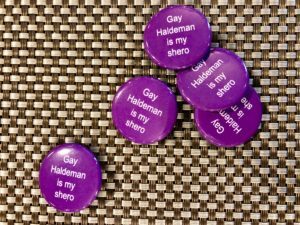 Back when I was VP of SFWA, Executive Director Kate Baker told me she had a dream. “I want to make the Nebula conference -the- premier conference for professional F&SF writers,” she said. “Something that no one wants to miss. A conference so good that if someone has budget for only one convention each year, that’s the one they know they’ll get the most value out of.”
Back when I was VP of SFWA, Executive Director Kate Baker told me she had a dream. “I want to make the Nebula conference -the- premier conference for professional F&SF writers,” she said. “Something that no one wants to miss. A conference so good that if someone has budget for only one convention each year, that’s the one they know they’ll get the most value out of.”
It seemed like a pretty good goal to me. After all, the Science Fiction & Fantasy Writers of America is over fifty years old, has close to 2000 members, including some pretty impressive names, has and continues to do major work in the field protecting professional F&SF writers, and gives out one set of the industry’s major awards as well as the recognition of the SFWA Grand Mastership.
It’s five years later, and in my opinion, Kate’s done what she set out to do. She didn’t do it alone, of course. She had the help of a whole lot of amazing SFWA staff and volunteers, including the amazing Terra LeMay and Steven H Silver. Mary Robinette Kowal got turned loose on programming the last couple of years and has been doing a stellar job. And others have made their mark with additions, such as the Nebula Award Alternate Universe Acceptance speeches or the mentoring program led by Sarah Pinsker or (I’d like to think) two I’ve contributed: the volunteer appreciation breakfast as well as the spouses and partners reception that have been regular features (and I hope will continue to do so!) Or the Book Depot, because I don’t know of ANY other con that takes as much care to make sure that its authors — including the indies — can sign and sell their books there. And there’s a fancy Nebula website, which remains a work in progress as more and more gets added to it, preserving the history of the Awards.
We’ve only got a small fraction of the schedule so far, with plenty of new stuff getting added every day, but here’s some highlights.
Panels about interesting things that may lead to story ideas, like the Future of Death, Realistic Military in Fiction, and Megatrends in the Near Future.
That mentoring program has grown every year, and now we do it at WorldCon as well. People new to the Nebulas can go knowing they’ll have someone there to explain stuff and fill them in on the etiquette of things as well as provide a friendly face and introduce them to people.
Interesting, innovative programming that comes in a variety of forms, including the Ignite talks and office hours, stuff that ranges all over the place and includes things like deep dives into Facebook advertising or what life aboard a space station is like.
A chance to explore some new areas of fiction, such as one of the several Interactive Fiction or Writing for Hollywood panels.
Plenty of panels aimed at indies and hybrids like myself, including the Self-Publishing Committee Town Hall, which should have plenty of crunchy info about recent and upcoming self-publishing events.
Panels that talk about practical things, such as combining parenthood and writing, productivity tools, or make-up basics for writers about to make media appearances.
The yearly What Teens Are Looking For in YA is a great panel that features actual teens talking about what they like to read and how they discover it, which is always informative. I think this is the 5th year (?) for this panel.
Memorials to a few of our lost greats, such as Ursula K. Le Guin and Vonda N. McIntyre. SFWA’s got a lot of history, and the Nebulas give us a chance to celebrate some of the folks we’ve lost each year.
I don’t mean to imply that the old version of the Nebulas was not what they promised to be. They were a chance to mingle and meet, but programming was usually slim and single track at best, and sometimes the topics were very broad indeed. They didn’t feel like a professional conference so much as a party. That’s fun, but it doesn’t give members stuff they actually need to be successful at what they do.
So…well done, Kate. You deserve a lot of applause for the effort you’ve led and you did exactly what you said you would do. The Nebulas now also stay within their budget, which is impressive, and has made enormous strides towards paying for itself, an important thing at a time when we see SFWA’s budget changing and adapting to the new publishing landscape.
It’s my last Nebula weekend as SFWA president, so I’ll be flitting around with a lot of relief on my face. Please say hi, but more importantly, please tell Kate and her team how much you’re enjoying the conference. I’m really going to miss working with this group of fabulous, amazing, talented people.
Recent News and Changes from Chez Rambo
 I’m very pleased to announce that Tor has acquired my recent space fantasy (maybe?), as part of a three book deal, and I’ll be working with Christopher Morgan there. While I’ve had a lot of short stories published traditionally, this is the first novel to go through that, and I’m looking forward to seeing what the process is like. What is the book about? Well, I’m actually not sure of the genre but have been describing it as a banter-driven space military fantasy in which a group of ex-military turned restauranteurs get an unexpected package, just as things start exploding. I’m 40k words into the sequel.
I’m very pleased to announce that Tor has acquired my recent space fantasy (maybe?), as part of a three book deal, and I’ll be working with Christopher Morgan there. While I’ve had a lot of short stories published traditionally, this is the first novel to go through that, and I’m looking forward to seeing what the process is like. What is the book about? Well, I’m actually not sure of the genre but have been describing it as a banter-driven space military fantasy in which a group of ex-military turned restauranteurs get an unexpected package, just as things start exploding. I’m 40k words into the sequel.
I’m so pleased by this and blissed out to the point where I’ve been grinning all week. The book was written last October/November as part of a change in my writing routine, and if that routine pays off this well, you better believe I’m going to stick to it. So — up at 5:30 AM and off to the gym, then only writing through 11 AM. I love these characters, who are a lot of fun, and they’ve informed me they’ve got plenty of story to tell.
This does change a few things: I will not be taking new coaching clients, and the only editing projects I will be doing are ones where I really want to be doing the edit. I will still be delighted to write stories for anthologies as well as sending stuff out — I’ve been finishing up a couple of stories this week. I’m also going to be stricter about no internet till 11 AM and will be a lot more hardass about not scheduling calls or other stuff during that time.
I will still be teaching and running the Rambo Academy for Wayward Writers — I get so much inspiration from those classes that I would be sad not to do them and I do want to eventually have on-demand versions of all of my classes up there. After 2019 is over, though, I may start claiming a few more weekends for my own.
 For those worried about the plight of Bella, Teo, Adelina, Sebastiano and the other Tabatians, I remain committed to being a hybrid author and I do intend to finish up the Tabat Quartet. =) If you want Tabat snippets and other creative pieces, please consider supporting my Patreon. Or encourage small press efforts by picking up one of my collections (Altered America (steampunk), Near + Far (SF), or Neither Here Nor There (fantasy)) or the Tabat novels from Wordfire Press! Otherwise, you might like to try the recent anthology that I edited, If This Goes On, from Parvus Press. Curious about how all this writing happened? Pick up my nonfiction book, Moving From Idea to Finished Draft.
For those worried about the plight of Bella, Teo, Adelina, Sebastiano and the other Tabatians, I remain committed to being a hybrid author and I do intend to finish up the Tabat Quartet. =) If you want Tabat snippets and other creative pieces, please consider supporting my Patreon. Or encourage small press efforts by picking up one of my collections (Altered America (steampunk), Near + Far (SF), or Neither Here Nor There (fantasy)) or the Tabat novels from Wordfire Press! Otherwise, you might like to try the recent anthology that I edited, If This Goes On, from Parvus Press. Curious about how all this writing happened? Pick up my nonfiction book, Moving From Idea to Finished Draft.
I’m done with the SFWA presidency as of July 1. Those of you who remember back before that time will recall how alarmingly productive I could be when I set my mind to it. You have no idea how much is coming. =)
April 10, 2019
Where I’ll Be: Norwescon, 2018
Friday
FOSTA-SESTA
10:00am – 11:00am @ Cascade 9
Sienna Saint-Cyr, Cat Rambo
Reading: Cat Rambo
1:00pm – 1:30pm @ Cascade 3
Cat Rambo (M)
Negotiating Contracts
3:00pm – 4:00pm @ Evergreen 3 & 4
Cat Rambo (M), Patrick Swenson, Yanni Kuznia, Jack Skillingstead
Writing Class: Writing Fiction with Empathy, Insight and Hope with Cat Rambo
4:30pm – 6:00pm @ Cascade 12
Cat Rambo (M)
Saturday
Want to be an Editor?
10:00am – 11:00am @ Cascade 9
Chimedum Ohaegbu, Gordon Van Gelder, Cat Rambo, Jasmine Silvera
Autograph Session 2
11:00am – 12:00pm @ Grand 2
Nancy Pearl, Mary Robinette Kowal, Daniel Koboldt, Neil Clarke, Tran Nguyen, Yanni Kuznia, Kurt Cagle, Rhiannon Held, Kat/K.R. Richardson, Cat Rambo, Jack Skillingstead, Patrick Swenson, Kay Kenyon, Sienna Saint-Cyr, Peter Orullian, Lisa Mantchev, Louisa Morgan, Brenda Cooper, Laura Anne Gilman, Sandra M. Odell, John (J.A.) Pitts
What is SFWA? (Science Fiction Writers of America)
1:00pm – 2:00pm @ Cascade 11
Cat Rambo (M), Curtis C. Chen, Adam Rakunas, Patrick Hurley
Need an Editor?
4:00pm – 5:00pm @ Cascade 7 & 8
Cat Rambo (M), Cory Skerry, Jaym Gates, Rhiannon Held, Jasmine Silvera
Online Presence for Authors
5:00pm – 6:00pm @ Cascade 7 & 8
K Tempest Bradford (M), K.G. Anderson, Cat Rambo, Chimedum Ohaegbu
Sunday
Writing Class: Writing Your Way Into Your Novel with Cat Rambo
11:30am – 1:30pm @ Cascade 13
Cat Rambo (M)
March 26, 2019
Writing Contests and Fees
 I recently tweeted this: “PSA/Pro tip: Do not submit to writing contests that charge entry fees. No ifs, ands, or buts.”
I recently tweeted this: “PSA/Pro tip: Do not submit to writing contests that charge entry fees. No ifs, ands, or buts.”
Many folks agreed; others wanted to argue a bit. Let us remember here that I am speaking as someone representative of professional writers, and that I have some experience with selling short stories as well as editing and publishing them.
One thing that guides my thinking is this: There is a thing in science fiction circles known as Yog’s Law, which is that the money always flows towards the writer. (If you are self-publishing, that flow may get circuitous, but generally you should not be putting money into increasing the profits unless you are getting the lion’s share of them.)
Here are the arguments that have come my way, and my opinion on them. Some are reasonable; others seem less so for me.
Sometimes what you get in return for the fee is a good value. This is an argument I have some sympathy for, because I know getting professional critiques and acknowledgement is sometimes instructive and usually pleasant. I’ve submitted to a contest because the prize involved personal interaction with the judge and I figured it was pretty much the same as buying a raffle ticket for it. But such contests are the exception rather the norm. No matter what, think about the fee and weigh it carefully, as well as whether or not you are guaranteed to get it. I’ve seen some fees ranging a hundred dollars and up and that starts getting pretty iffy. If you’re paying that much for the same sort of brief editorial feedback you might see when submitting stories, why not just submit them?
Sometimes the fee supports a charity or writers organization. Again, some reason behind this argument, but it would be more efficient to give them the money directly. I have been working with a nonprofit for close to five years now, though, so I understand the fundraising woes. This is, though, an inefficient way of raising funds that depends on a great deal of volunteer time and energy and the ROI is iffy, depending on the skill of the people running things. Perhaps the organization might look into membership fees, pledge drives, bake sales, crowdfunding, or other alternate means of funding.
Charging a fee is a way for a magazine to support itself. There are other, better ways to make money than to monetize the writers, and it’s also a bit cynical not to believe in your product to the point where you think the main audience is the people who want to publish in its pages.
Charging a fee means better submissions. Great reason for editors and magazines; meaningless to writers and in fact, means people that self-reject will be even more likely to do so. It also ensures economically disadvantaged people don’t get to participate. The price of a latte for one person may be the next person’s daily food budget.
A fee contest is how a small press finds new manuscripts to publish. No. Plenty of small presses do not do this.
There are reputable contests out there charging fees. Sure! But if you have a story that you think is publishable, send it out to a magazine. Going the route of writing and submitting stories is a more efficient process of moving upward as a writer than submitting to contests.
Contests get the writerly juices flowing and encourage people to write. If that works for you, swell. Some people can only write in a particular kind of notebook; others only in a coffeeshop with a triple macchiato. Be aware not everyone can afford it, and that you’re tacitly encouraging the system, and then base your decision on how cool or not you are with that. Mileage will vary, but I personally like to know the basics of whichever route I’m taking.
Overall, my feeling is that a magazine that charges fees for contests views the people submitting stories as a source of income, not as partners in the publishing venture. Beyond that — and more importantly, to my mind — a publishing model that publishes only the people that can afford to submit means only the economically privileged can participate and therefore discourages economic diversity – which, in this intersectional world, affects some groups more than others.
That said, there are definitely some contests out there that are well-meaning while others are downright predatory. If you’ve got a question about one, you should check the Writer Beware website and contact them if you don’t see information about it there.
And if you find a contest that doesn’t charge a fee? Still read the rules carefully. A contest should not automatically give the runner publishing rights to the entries, for example, but many ask for that in the fine print. Got a question about a contract? The SFWA Contracts Committee may be able to assist.
Wondering how to get started sending stories out? Here’s a brief video with the basics:
Given that I sell classes to writers myself, is coming after contests capitalizing on people’s dreams of being writers a bit hypocritical of me? Mmm, maybe. I try to counteract things by offering a lot of free scholarships and providing what I think is pretty good value for my students, and I try to steer them away from scams and exorbitant prices.
Want more advice like this? Check out these resources for F&SF writers or sign up for my newsletter.
March 20, 2019
Resist Through the Way You Exist
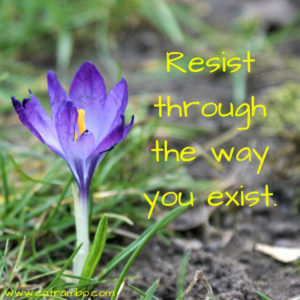 One thing that’s emerging from discussion about the New Green Deal is that to act ecologically, to believe that climate change is real and that we must all work together to avert the worst of it, is now considered by some a radical leftist notion.
One thing that’s emerging from discussion about the New Green Deal is that to act ecologically, to believe that climate change is real and that we must all work together to avert the worst of it, is now considered by some a radical leftist notion.
It is a given that the corporations must change their ways, must stop polluting and destroying the commons – the natural resources that belong to us all as citizens of this planet. The government must stop rolling back environmental protections — and put back the ones it’s stripped away while also stopping the flow of those resources to profiteers. But at the same time we as individuals can live in ways that help move us evolve into a society that places less strain on our planet.
You can #resist through the way you exist, and particularly the ways you spend money. Corporations have developed enormous systems designed to sell you stuff, to create anxiety in you and then offer material goods promising to soothe that anxious ache. All that angst will go away if you just buy the right celebrity’s brand, they say, and then laugh all the way to the bank while you stand there, not sure how you’ve been conned. Opt out!
Here are some things I’ve been trying to do more of this year:
Cooking more, and buying less pre-packaged or take-out food. I make the majority of our dinners (often quite quickly, due to the InstantPot). It’s cheaper and (usually) healthier plus it gives me more control over the ingredients. I do like my walk to the coffee shop in the morning; nowadays I bring my coffee thermos mug with me rather than use their paper cup.
Some of what I’m cooking comes from Imperfect Produce, which I’m finding convenient, plus a little cheaper. Imperfect Produce sells both organic and regular produce that isn’t consistently sized or pretty enough to go into the grocery store.
Reducing food waste through several other means, including using leftovers up whenever I can. A recent roast, for example, became a savory sauce over gnocchi the next night, and finished its existence as a soup. And the vegetable peelings from the meals all got popped in a plastic bag in the freezer; when there’s a full bag, I’ll make stock out of it. I like to make my own yogurt; the whey from that gets frozen and added to soups.
Another means of reducing waste is composting more, now I have a place with a yard. I might have gone a little compost nuts, actually. There’s a rolling bin for yard waste, a bokashi fermenter on its way, and a space reserved for a worm bin. But there’s enough garden space here that it will be useful!
I have always used simple stuff to clean with rather than buying heavily perfumed cleaners that make me sneeze. Try out baking soda instead of scouring powder, frozen chunks of fruit rather than garbage disposal deodorizers (also uses up aging fruit), wool dryer balls rather than fabric softener, olive oil based furniture polish, or vinegar and water for glass surfaces.
Making my own presents or giving experiences rather than things. Whatever your feelings on Marie Kondo, she does have a point when it comes to amount of useless stuff people accumulate. Why add to the the mass of that, when a batch of cookies might be more appreciated + don’t go on to take up shelf space for years? It doesn’t have to be sweets. It could be a plant you’ve started, a savory spice mix, or a scented bath bomb. There’s a LOT of DIY possibilities. Or take someone for a walk or to a concert they’ll enjoy.
I’ve always preferred thrift shops (perhaps because I was heavily influenced by Tanith Lee’s The Silver Metal Lover as a child) and that’s certainly not going to change, but I’ve also got enough space to pull out the sewing machine and either spend some time tweaking stuff I’ve accumulated or get rid of it.
Corporations don’t care about you, but they do care about the money that flows through your hands. Buy locally and from independent creators where you can, boycott the egregious bad behavers — and let them know that you are doing so — and overall make what you spend count where and when you can.
Remember that in this modern world, kindness, mindfulness, and honesty are as punk as you can get. Don’t buy into the cynicism enforced by edge-lord humor. It dulls your empathy and numbs you into acceptance of things as they are. Celebrate your differences and those around you.
#sfwapro
March 14, 2019
Guest Post: Valerie Nieman on Going Away and Coming Home
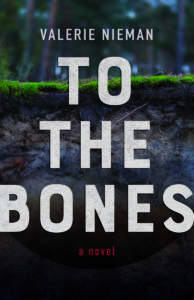 Thomas Wolfe claimed “you can’t go home again,” but the place you sprang from is never going to go away from you, that’s for sure. It’s down there in the isotopes layered into your bones and teeth. It’s there in the way your accent shifts when you go home for a visit, no matter how long away nor what education’s done to change you.
Thomas Wolfe claimed “you can’t go home again,” but the place you sprang from is never going to go away from you, that’s for sure. It’s down there in the isotopes layered into your bones and teeth. It’s there in the way your accent shifts when you go home for a visit, no matter how long away nor what education’s done to change you.
My new book, To the Bones, takes me back to the West Virginia I knew, a place both beloved for its “wild, wonderful” hills and source of despair for its history of exploitation. It also brings me home to genre fiction, after a long time wandering (mostly) in the paths of literary and mainstream writing.
The book began because I couldn’t get started. I was completing a novel-in-verse that had been long in the gestation, and was ready for the next project, but a couple of false starts had left me cranky. I complained to a writer friend about how poorly things were going. The conversation rolled around to a discussion of how to dispose of a body, and I commented, “When I was back in West Virginia, I always said that if I murdered someone, I’d throw them down a mine crack.” He challenged me to do so, and to make it a horror novel.
I was off and running, with a book that would bring together Appalachian legends, zombie movies, quest literature, ecojustice, Celtic lore, and a bit of romance. To the Bones is a satirical look at the legacy of coal mining in West Virginia through a splintered genre lens.
My years as a farmer and newspaper reporter in the northern coalfields provided both setting and substance for the novel. I’d struggled with the lack of water after mining cut off the springs and wells at my hill farm. You generally own only the “surface rights” when you buy land in coal country, which meant that subterranean water was not guaranteed, nor did I stand to profit from the capped gas well in the back field. (That property is likely fracked by now.) My land rested above part of the Farmington No. 9 mine, where an explosion 50 years ago left 78 men dead—the bodies of 19 of them left entombed because it was too dangerous to reach them. A mine crack extended over a corner of the back pasture; another marred a neighbor’s field.
As a reporter, I’d covered mine accidents, train derailments, murders, wildcat strikes, mine subsidence, town meetings and camp meetings. Those memories came back, including the lethal orange color of acid mine drainage that painted the destroyed streams.
The very shape of the land found its way into fictional Carbon County, as it did in my first novel, Neena Gathering, published in 1988 and resurrected by Permuted Press a couple of years ago as a classic post-apocalyptic story. There are many ties between my first book and this most recent outing, including a number of settings loosely based on places where I went to school, farmed, fished, and worked at newspapers. Characters end up below ground, in pits and abandoned mines and that aforementioned mine crack, because that’s just what I do—Fred Chappell remarked once that my interests were chthonic, and from Neena onward, what lies hidden or buried has served to wind taut the warp of story.
To the Bones came quickly, and I’m a slow writer, so I have the feeling I’d already been on the road “home” for a while. I published a crime drama in 2012 that’s set in tobacco country, but the protagonist is from northern Appalachia. My latest poetry collection, Leopard Lady: A Life in Verse, begins in Kentucky and follows a mid-century carnival sideshow traveling the region from Pennsylvania to South Carolina.
I’d left the mountains, but they hadn’t left me. While most people think of “Take Me Home, Country Roads” as the West Virginia state song, which it’s been since 2014, I always think that “Green Rolling Hills” addresses the Mountaineer’s pain of leaving more directly—check out the lyrics here.
In terms of genre, I’d gone away like the speaker in Utah Phillips’ song, but the joys of writing spec fiction “never let me go” and were right there waiting to welcome me back when I found that returning road.
Here’s an old-time peach cobbler recipe from among those I’ve collected over the years. In my family, the fruit went in first and some kind of dough went on top, though I’ve known some will put the dough down and pour the fruit over. I don’t know what recipe Darrick uses, but the traditional dessert plays a small role in To the Bones. Just the thing to welcome home a weary wanderer.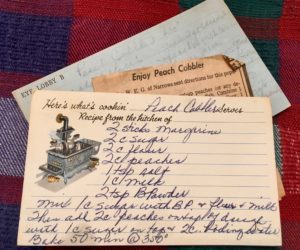
Peach Cobbler
6 cups peaches, sliced
1 TBSP lemon juice
1/4 C packed brown sugar
1 and 1/2 TBSP cornstarch
1/2 C water
1/2 C sugar (white)
1/2 C flour
1/2 TSP baking powder
1/4 TSP salt
2 TBSP butter, softened
1 large egg
Grease two-quart casserole.
Put peaches in, stir in lemon juice.
Stir brown sugar and cornstarch, gradually add water. Cook about 5 minutes.
Pour over peaches.
Set aside 1 TSP sugar.
Stir together sugar, flour, baking powder and salt. Stir in butter and egg until soft dough forms. Drop over peaches. Sprinkle over 1 TSP sugar.
Bake 40-45 minutes at 400 degrees F

Valerie Nieman is a poet and novelist whose first West Virginia novel, Neena Gathering, was returned to print in 2013 as a classic in post-apocalyptic literature. She’s also the author of Leopard Lady: A Life In Verse; Blood Clay, a crime drama set in North Carolina; and a collection of short stories and two additional poetry collections. To the Bones drops on June 1 from West Virginia University Press.
News and excerpts from her work can be found at:
Facebook @valerienieman1 – https://www.facebook.com/valerienieman1/
Twitter @valnieman – https://twitter.com/valnieman
Instagram @valnieman – https://www.instagram.com/valnieman/
Website valnieman.com
Enjoy this writing advice and want more content like it? Check out the classes Cat gives via the Rambo Academy for Wayward Writers, which offers both on-demand and live online writing classes for fantasy and science fiction writers from Cat and other authors, including Ann Leckie, Seanan McGuire, Fran Wilde and other talents! All classes include three free slots.
If you’re an author or other fantasy and science fiction creative, and want to do a guest blog post, please check out the guest blog post guidelines.
March 13, 2019
Hopepunk Thoughts Plus A Reading List
 As mentioned in the Wall Street Journal (hello new readers coming from there!) last year, I came up with a new class, “Punk U: The Whys and Wherefores of Writing -punk Fiction“, which attempted to explore some of the -punk subgenres, starting with cyberpunk and progressing through steampunk, dieselpunk, nanopunk, solarpunk, afropunk, monkpunk, mannerpunk, and a dozen others. Of all of them, the most fascinating to me — and the one that’s had the greatest influence on my recent fiction, is hopepunk.
As mentioned in the Wall Street Journal (hello new readers coming from there!) last year, I came up with a new class, “Punk U: The Whys and Wherefores of Writing -punk Fiction“, which attempted to explore some of the -punk subgenres, starting with cyberpunk and progressing through steampunk, dieselpunk, nanopunk, solarpunk, afropunk, monkpunk, mannerpunk, and a dozen others. Of all of them, the most fascinating to me — and the one that’s had the greatest influence on my recent fiction, is hopepunk.
What is hopepunk? The term was first coined by Alexandra Rowland as the antithesis of “grimdark,” a speculative genre featuring fatalistic nihilism and a tooth vs. claw environment. She wrote:
“The essence of grimdark is that everyone’s inherently sort of a bad person and does bad things, and that’s awful and disheartening and cynical. It’s looking at human nature and going, ‘The glass is half empty. ‘Hopepunk says, ‘No, I don’t accept that. Go fuck yourself: The glass is half full.’ Yeah, we’re all a messy mix of good and bad, flaws and virtues. We’ve all been mean and petty and cruel, but (and here’s the important part) we’ve also been soft and forgiving and kind. Hopepunk says that kindness and softness doesn’t equal weakness, and that in this world of brutal cynicism and nihilism, being kind is a political act. An act of rebellion.”
She wrote more about hopepunk in a follow-up essay, “One Atom of Justice, One Molecule of Mercy, and the Empire of Unsheathed Knives and expands on the idea of kindness as a political act further in this great essay:
Just the amount that I have seen people get more politically active in the last year has been amazing. I want to point out that kindness doesn’t necessarily mean softness. Kindness can mean standing up for someone who’s being bullied. If someone has a gun to your friend’s head, punching the guy with the gun is an act of kindness because you’re saving someone through that. So kindness is not always soft.
Kindness is not necessarily passive. Kindness is something that you can go out and fight for. Going to a protest, if you frame it in a particular way, is an act of kindness because you’re doing something for the future. You’re contributing to the future. You’re putting more good in the world is I think how I would define doing kindness. If you see someone being shouted at by a bigot on the subway, just standing up for them and having their back is an act of kindness.
And being kind also is something that requires so much bravery sometimes.
Others seized on the term with joyous abandon — and one of the signatures of hopepunk is, in my opinion, a sense that the writer is creating happily and full throttle. I’d call a number of the works on this year’s Nebula Award ballot hopepunk, particularly Trail of Lightning and The Calculating Stars, and I suspect there will be plenty of it on the Hugo and World Fantasy ballots this year as well.
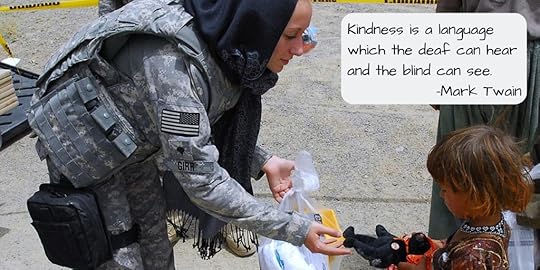
Hopepunk is a reaction to our times, an insistence that a hollow world built of hatred and financial ambition is NOT the norm. It is stories of resistance, stories that celebrate friendship and truth and the things that make us human. In today’s world, being kind is one of the most radical things you can do, and you can see society trying to quash it by prosecuting those who offer food to the hungry, water to the thirsty, and shelter to those in need.
Is it something new? No, it’s something that we’ve always celebrated in stories. Think about the moment in the Lord of the Rings when acts of kindness — first on Bilbo’s part, then on Frodo’s — lead to the moment where Gollum enables the ring’s destruction when Frodo falters and is on the brink of giving up his quest. Or go even further back, to Ovid’s Baucis and Philemon, who are rewarded for offering hospitality to strangers who turn out to be gods.
But in recent decades we’ve let other, darker stories, mocking the earnest and shredding empathy, supplant those fables. Stories written by the kleptocracy, designed to make its victims despair and give way to apathetic acceptance, stories spat out daily by the messageboard shitlords trying to convince us that meme-based mockery should be the first reaction to any appeal to the human heart. They’re there to enforce the rule that to step away from the line– to be joyous or non-conforming or outside the system in any way — is to be aberrant and wrong.
One of the things resisting that is hopepunk. The movement has caught on, with some perceiving it as vital to sowing the seeds of resistance, as with Vox describing it as “weaponized optimism”, adding “Hopepunk combines the aesthetics of choosing gentleness with the messy politics of revolution.” In an article for America, Jim McDermott went so far as to call it “quintessentially Catholic“, saying:
Death on the cross, understood not as some brutal cosmic math equation but a personal choice to continue to love and give and believe even when your life is at stake, is the beating heart of Catholic hopepunk. So is Jesus’s vision of the Kingdom of God as a banquet where all are welcome and called to kindness, and the lives of holy people like Martin Luther King, Jr., St. Francis of Assisi or Mary MacKillop, R.S.J., who refused to accept the premises of the reality in which they lived and experienced their own deaths and resurrections as a result. It’s Greg Boyle, S.J., insisting “There is no ‘them’ and ‘us,’ there is only us,” young people from all over the world traveling to Panama to create and imagine the church or Mary Oliver inviting us over and over in her poetry to consider “our one wild and precious life.”
Hopepunk is a movement that understands the importance of stories and how they can affect change, and so hopepunk often — perhaps even usually — has casts that are as diverse as the world around us, featuring characters of color, transexuals, a-romantics, differently-abled, and more, building empathy by showing that there are certain basic things any of us want, regardless of which other or others we do or don’t belong to.
In thinking about it, I find that hopepunk has crept into my life over the past few years. The Feminist Futures Storybundle I just curated holds more than one example, as did last year’s version of it. The anthology I edited last year, which appeared at the beginning of this month, If This Goes On, is full of examples of it.
Hopepunk led to me creating the class “Stories That Change Our World: Writing with Empathy, Insight, and Hope“. I spoke at length about the creation of the class in a recent essay for Clarkesworld magazine, but I could easily have titled the class, “The How-tos of Writing Hopepunk” and captured the same spirit.
One of the charms of the hopepunk definition is that it’s somewhat expandable — happy + hopeful, plus an insistence that it’s not a totally hostile universe, seems to be the base definition. In fact, it doesn’t have to be speculative fiction. Here’s Bryn Hammond talking about examples of it in historical fiction.
One of my favorite writers, Kurt Vonnegut Jr., often preached kindness in his work. He also said, “Be careful what you pretend to be, because you become it.” Try being kind, being mindful of your impact on the world and lives around you, and you may be surprised at exactly how kind you can be.
Recently hopepunk has elbowed its way into my writing as well, insisting on the importance of kindness and community. I just finished up a story where that instinct plays an important part, and I know that the next story I’m turning to, about animatronic Beatles in a post-apocalyptic landscape, will have many of the same resonances. Is this a deliberate focus or accidental? I’m not sure, but I feel hopeful about it.

HOPEPUNK READING LIST
Hopepunk novels:
Becky Chambers, The Wayfarers Series (starts with The Long Way to a Small Angry Planet)
Joyce Chng, Water Into Wine
Nicole Kimberling, Happy Snak
Mary Robinette Kowal, The Lady Astronaut series
Edward Lazelleri, The Guardians of Aandor Series
Marshall Ryan Maresca, The Way of the Shield and Shield of the People
Elizabeth McCoy, Queen of Roses
Tehlor Kay Mejia, We Set the Dark on Fire
Alexandra Rowland, A Conspiracy of Truths
R.J. Theodore, Flotsam
Carrie Vaughn, Bannerless
Hopepunk games:
Return to the Stars
Hopepunk novels coming out in 2019:
L.X. Beckett, Gamechanger
Aliette de Bodard, House of Sundering Flames
Bryan Camp, Gather the Fortunes.
A.J. Hackwith, The Library of the Unwritten
Tyler Hayes, The Imaginary Corpse
Leanna Renee Hieber, Miss Violet and the Great War
Marshall Ryan Maresca, A Parliament of Bodies
Alexandra Rowland, A Choir of Lies
Ferrett Steinmetz, Sol Majestic
Bogi Takács, The Trans Space Octopus Congregation
R.J. Theodore, Salvage
Patrick Tomlinson, Starship Repo
K.B. Wagers, Down Among the Dead
If you have suggestions for additions, please mail them to me or suggest them in the comments!
March 11, 2019
Guest Post: Score One for Music by B. Morris Allen, Editor, Metaphorosis Books and Metaphorosis Magazine
What if prose were written like music? What if, instead, of a common world, stories in an anthology were steps on a share emotional path? Those are the questions the upcoming anthology Score is attempting to answer.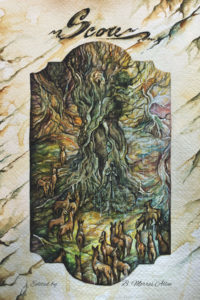
Emotions are a key part of our experience of art. The books that stick with you are often the ones that made you feel something. Even when we don’t recall the details of a plot (or painting, or movie), we’ll often recall how it made us feel. Even if you don’t recall the details of Watership Down, for example -— the names of the rabbits, the original warren, etc. — you probably remember how you felt about the rabbits and what happened to them. You remember how you felt when you closed the book. Even if you mislay every detail of a book, you’ll remember whether it made you laugh or cry or feel wistful.
Score is an attempt to tackle the emotional side of writing head on. A group of almost 20 authors set out not to write about robots or aliens or magic — though we have all of those — but to write from emotion.
What does that mean, and how does it work? It means, simply, that each of the authors worked from a coherent emotional score, knowing the emotions in the piece before and after theirs, what emotions they were to emphasize, and … nothing else. They had complete freedom of genre, topic, tone, approach, etc. — so long as they worked with the emotions they were assigned. The result is a fascinating collection of stories with a distinct emotional progression.
Putting together the score was challenging. As the editor and ‘composer’, I defined fairly early on the emotions we would work with. I knew the direction I wanted to score to take – an overall path of ascending hope that I thought a good fit to the times — but choosing emotional terminology that would work consistently across many different writers took some work.
In the end, we worked from a palette of six emotional ranges – six emotions with four variants each, two positive, two negative. For example, Hope ranges from Hope at the positive end to Despair at the negative end. These aren’t quite the emotional pairs used by social scientists, and we could have ended up with a wide range of others, but these six emotional ranges allowed ample scope for ups and downs. The emotions are loosely grouped into two sets – the Hope set (Hope, Curiosity, Awe) and the Joy set (Joy, Love, Lust).
Each writer was assigned a specific major and minor emotion, and the score has distinct movements. Using musical terms very approximately, there’s an Overture, a Hope triad, a Joy triad, a Bridge, a Joy triad inversion, a Hope triad inversion, and a Coda. There are high points and low points, but … spoiler alert… it all ends with Hope and Joy.
It’s been a lot of fun putting this together. While I personally often write from an emotional basis, putting together an entire score was an intriguing and challenging exercise. Each writer interpreted the task in their own way, putting their own distinct stamp on it, as artists will. The result is intriguing, and I hope will be as much of an adventure for readers as it was for all of us.
Score: an SFF symphony is out on March 2nd from Metaphorosis Books.
Enjoy this writing advice and want more content like it? Check out the classes Cat gives via the Rambo Academy for Wayward Writers, which offers both on-demand and live online writing classes for fantasy and science fiction writers from Cat and other authors, including Ann Leckie, Seanan McGuire, Fran Wilde and other talents! All classes include three free slots.
If you’re an author or other fantasy and science fiction creative, and want to do a guest blog post, please check out the guest blog post guidelines.




